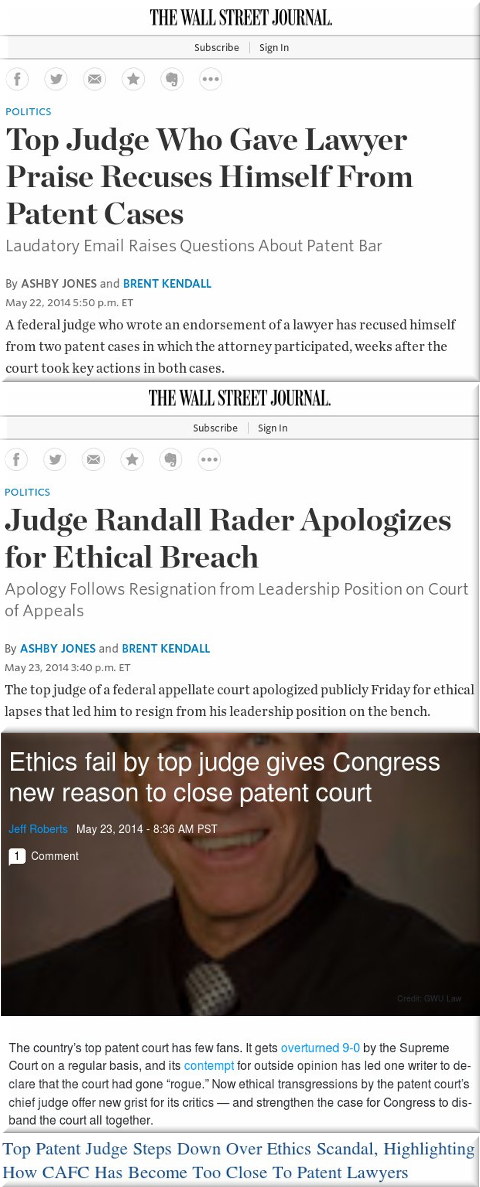

The above [1, 2, 3, 4] are symptoms of a much broader and systemic problem
"The data released from the USPTO in its annual report shades the truth somewhat," wrote Patently-O yesterday. "but includes a number of important signals."
"The Federal Circuit may as well just become synonymous with or renamed to Federal Patent Court."The EPO's report also shaded the truth. That's what these self-serving (and not independent) reports do. In the case of the USPTO -- as is increasingly the case under Battistelli at the EPO -- only numbers count, not quality. The integrity of the processes (notably examination) is severely compromised in the name of short-term monetary gains. This is not acceptable.
Another new article from Patently-O says that "the Court of Appeals for the Federal Circuit (“CAFC”) hears patent appeals, but some readers may be surprised when told that the CAFC also hears, inter alia, appeals from the Court of Appeals for Veterans Claims (“CAVC”)."
Techrights spent years writing about the Federal Circuit, which is rife with corruption and patent maximalism, including software patents which originally came about from there. Anything that gives CAFC even more power would put at risk the entire system. Patently-O says that the "Federal Circuit Now Receiving More Appeals Arising from the PTO than the District Courts". It's all about patent feuds now. Good for patent lawyers, not for anybody else except their biggest clients (large corporations). "Appeals arising from district court patent infringement cases," wrote Patently-O, "have historically made up about a third of the court’s docket. In 2011, for example, appeals from the district courts constituted 33% of appeals filed, while appeals from the PTO were about 9%."
The Federal Circuit may as well just become synonymous with or renamed to Federal Patent Court. Here is a patent lawyer (from Troutman Sanders) writing about CAFC, bemoaning the Patent Trial and Appeal Board (PTAB), as usual, as PTAB helps crush software patents. To quote one paragraph, "Judge Newman wrote in dissent that the PTAB’s interpretation runs afoul of the AIA’s intent to create an efficient alternative forum for resolving patent disputes, since a failure to resolve all claims before the PTAB leads to duplication in district court."
Actually, the district courts would not be needed if the USPTO properly did its job in the post-Alice era and PTAB completed the job by throwing in the trash invalid (e.g. abstract) patents that the USPTO erroneous of fraudulently (for personal gain) granted. Years ago we noted that the USPTO had been giving financial incentives to accept patent applications rather than reject/decline them. What kind of system is that? Is there any illusion left of objectivity?
MIP, another patent maximalism site, wrote yesterday about "PTAB issues to watch in 2016". It said that the "Patent Trial and Appeal Board is taking a harder line on institution, while PTAB watchers eagerly await a face-off at the Supreme Court over claim construction and the Federal Circuit increasingly pulls the Board up on procedural issues" (SCOTUS has already issued its judgment on that in the Alice case).
Writing about CAFC, Patently-O says that "In a split decision [it] has again rejected a jury verdict" (so much for justice). "Here," said the author, "the alleged infringing meters are designed to be bolted down to exterior walls and left in place for years. Of course, it is fairly easy for an electrician to move these meters and install them, but they are designed to operate in a fixed location once installed. The majority ruled that the best (and only reasonable) construction of the term involves both of these requirements (portability and non-permanent location)."
"Decades after CAFC brought all sorts of ludicrous patents to the US (notably software patents) they seem to be fading or ebbing away."Another new Patently-O post by Dennis Crouch says: "In an interesting and important mandamus ruling, the Federal Circuit has ordered the district court to withdraw its order compelling discovery of communications with non-attorney patent agents."
The Federal Circuit sure isn't doing much to improve its image. It engages not only in its own turf wars but also others'. Consider some belated comments on the recent Lexmark case (EN | ES) that appear in patent maximalism blogs [1, 2]. It increasingly seems like CAFC is so biased that it merely works for corporations, not for justice.
"US courts have become much more defendant friendly," wrote a software patents proponent yesterday, "district courts routinely find against plaintiffs asserting patents – particularly NPEs [patent trolls] – and if they don’t the Federal Circuit (CAFC) often overturns district court judgments."
This patent maximalist, Joff Wild, basically bemoans courts which don't support software patents (the trolls' favourite weapon) and he adds: "Specific decisions from the Supreme Court – Alice, Myriad and Mayo, for example - have had a direct impact on patentability in areas such as software, biotech and business methods."
This is of course a good thing. Decades after CAFC brought all sorts of ludicrous patents to the US (notably software patents) they seem to be fading or ebbing away. Patent maximalists (which include patent lawyers) won't tolerate this defeat. Neither will CAFC. ⬆